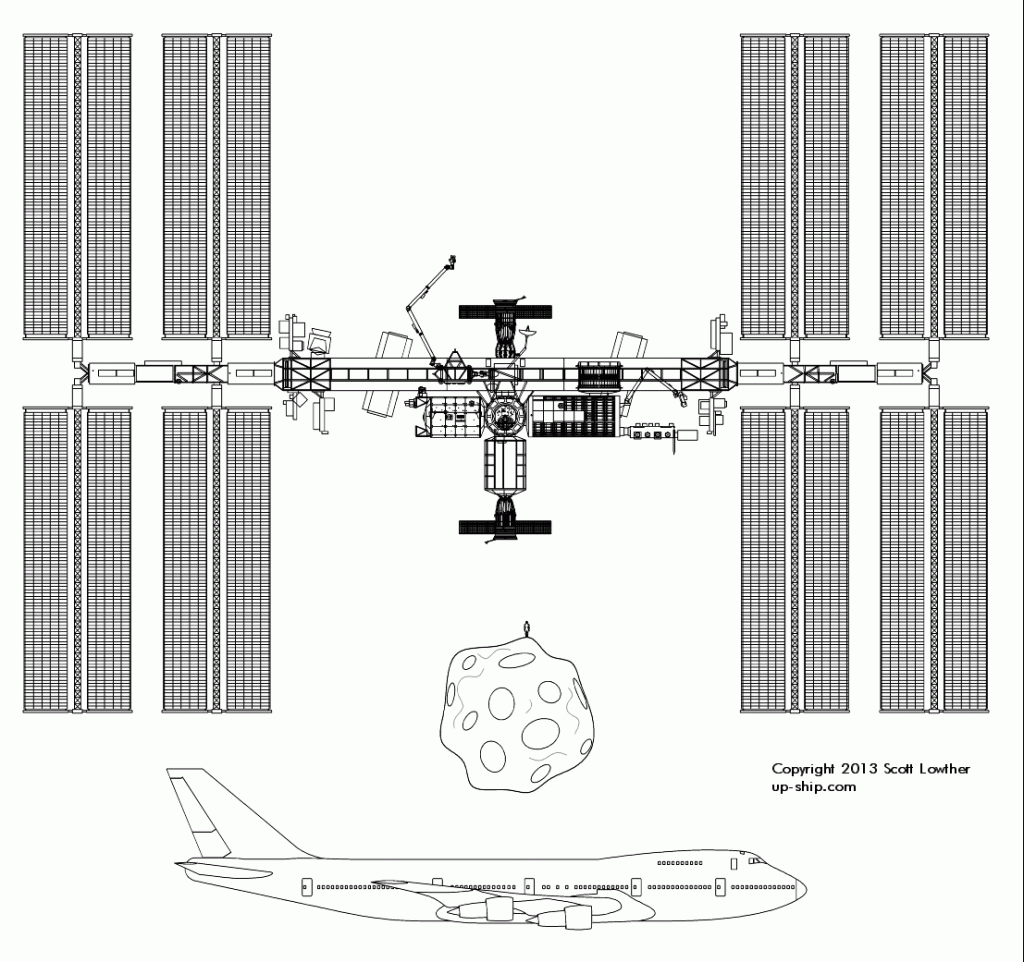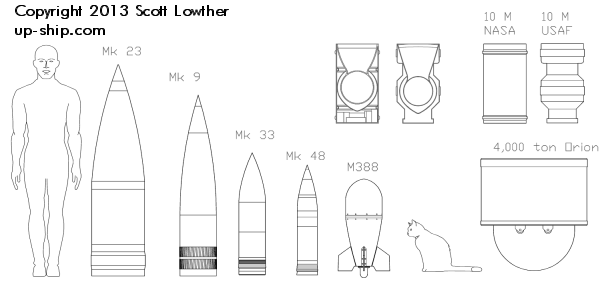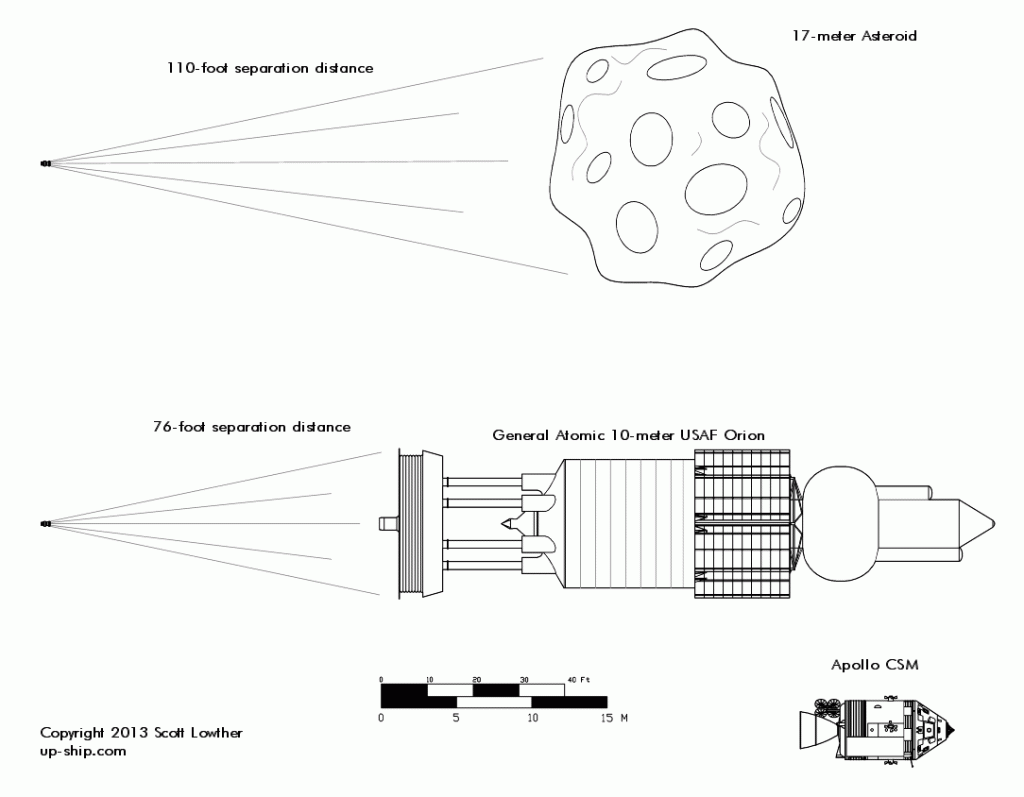Nukes have a poor reputation in the planetary defense community. Watch any documentary about the risk posed by asteroid or cometary impacts, and if they discuss mitigation techniques they will probably mention nukes only to tear them down. On one hand, they have a point: Hollywood has gone to great lengths to publicize nuking asteroids and comets, showing them being blown to flinders or even vaporized often by a single rather small bomb. And that is patent nonsense: a bomb big enough to render a threatening asteroid into gravel has not been invented, and could not be launched into orbit, let alone sent to deep space.
However, the fact that Hollywood gets it wrong does not mean that nukes are the wrong tools. For starters, what you don’t want to do is actually land the nuke on the impactor. You don’t want to try to vaporize it. You don’t want to turn it into a shotgun blast of sand. What you do want to do is nudge the impactor so that it simply misses the Earth. An asteroid on an impact trajectory is not some evil monster that has calculated a crime and needs punishing, any more than a raindrop has evil intentions. And like a raindrop, you don’t need to destroy it; just deflect it.

The Chelyabinsk asteroid compared to the ISS and a 747 to show scale. ISS drawing via HistoricSpacecraft.com
So how do you deflect an impactor with a nuke? One idea that has been floated is to stand off at some precise distance, and the gamma rays from the bomb will superheat the surface of the impactor closest to the burst. The superheated surface will flash to gas and “puff” off the surface giving a large, but widely distributed, mechanical shove. Sounds good, but it also sounds vague: without precise knowledge of the makeup of the surface of the asteroid and how that surface varies, the bomb might simply heat the surface so that it simply melts rather than vaporizes; this will provide no meaningful shove.
What’s really needed is a technique for using a nuclear bomb in order to provide a carefully calibrated mechanical impulse. And fortunately… that work has been done. Fifty years ago, General Atomic (only later renamed General Atomics) worked on Project Orion, a concept for a spacecraft powered by exploding nuclear bombs. Those who have not studied the results of their labor tend to think the idea is ludicrous; those who have studied the work realize that Orion was one of the great missed opportunities in all of human history. The physics worked; the engineering was on its way, but the politics of the time – and of all the time since – simply wouldn’t allow it.
The Orion system used “pulse units” for propulsion. A pulse unit was a nuclear device… but more than that. The nuke formed the heart of the system, but around the bomb was a depleted uranium shell that lasted just long enough to reflect a good fraction of the X-rays generated in the first microseconds into a single direction. The gathered X-rays were absorbed by a quantity of beryllium oxide. In absorbing the X-rays, the beryllium oxide was raised to truly vast temperatures. On the far side of the super-hot clump of beryllium and oxygen plasma was a round “lens” of tungsten. The plasma focused it’s thermal rage on the tungsten plate; in turn the tungsten also converted to a plasma. Being a more-or-less flat circular plate, the tungsten shot forward as a jet of gas, moving at a speed of around 1.5E7 cm/sec… 337,500 miles per hour. This jet of tungsten plasma would strike a large steel pusher plate attached to the back of the Orion spacecraft, and provide the needed “kick.” Shock absorbers would convert the millisecond slam into something that man and machine could easily survive.

Orion pulse units (at right) compared with several contemporary atomic artillery shells. The “10 meter” pulse unit was comparable in yield to the M388 shell used by the Davy Crockett recoiless gun; the “4,000 ton” pulse unit is comparable to the Mk 23 16-inch naval artillery shell.
So. The physics of pulse units was long ago worked out. The engineering was well underway; secrecy rules have prevented details from being made public, so the extent of progress on designing practical pulse units is unclear. However, what is clear is that the nuclear weapons designers were well on their way, and were probably only a few years – and some political commitments – from testing prototypes.
An Orion pulse unit would be just the thing for deflecting an impactor. Set off at the right distance, the jet of tungsten would spread out like a shotgun blast to *just* cover the face of the impactor. A direct and undeniable mechanical THWACK would be delivered. By spreading the impulse over the whole face, there would be less risk of actually blowing the impactor apart.
Several pulse units were described, ranging from sub-kiloton devices to several-dozen-kiloton devices. The smallest of the devices, at one-half to one kiloton, were meant to propel small ten-meter diameter Orion craft for the USAF and NASA. What we know about the USAF device is that the yield was one kiloton, had an overall diameter of 14 inches, a total weight of 189 pounds and a propellant (tungsten) weight of 75.5 pounds (34.3 kg). The total impulse delivered to the pusher plate was 453,000 lb-sec (2.01 MN-sec). This was enough so that a firing rate of approximately one per second would provide an average acceleration of well over one gee for the Orion craft.
The Chelyabinsk meteor had a mass, last I heard, of about 10,000,000 kilograms. Applying the pulse unit total impulse of 2.01 MN-sec, a single pulse unit should change the velocity of the asteroid by 0.2 meters per second. In Hollywood terms, this is incredibly weak and unimpressive; in real world terms, it’s pretty good.

The Chelyabinsk meteoroid in scale with an Apollo CSM and the 10-meter “USAF” Orion designed by General Atomic. Also shown is a standard pulse unit for the Orion in the proper detonation position… 76 feet away for the Orion and about 110 for the meteoroid.
With the ability to deflect the Chelyabinsk asteroid by 0.2 meters per second per pulse unit, how far in advance would the velocity change have needed to be applied to assure a miss? The meteor just barely skimmed the upper atmosphere. Another 50 kilometers further out, and it would probably not have been noticed. But let’s assume 100 km, just to be safe. So, 100,000 meters deflection at 0.2 meters per second means that interception would have had to have happened 500,000 seconds before impact… a mere 5.8 *days* out. If the asteroid could take the pounding of ten pulse units, that would drop the deflection deadline to 13.9 *hours* from impact.
But if you want to make absolutely sure, let’s deflect the asteroid by 10,000 km. If you can only be sure of a single pulse unit, the you would need to fire it 578 days prior to impact. This would be in very deep space, but well within the capability of an Orion vehicle. However, it appears that the Chelyabinsk meteoroid was not detected until the moment it entered the atmosphere over Russia. Any impactor mitigation system would have to do much better.
One clear way to aid in the detection of threatening celestial bodies is to have a sufficiency of visual and infrared telescopes, coupled with powerful radar systems. And a way to make this system even better is to locate “picket ships” in deep space… the Sol-Earth Lagrange points would seem a good choice. And how to get these picket ships out there? Orion would seem an effective means of transport. An added bonus would be that not only would impactor detection be located far from Earth, so would the actual mitigation system. By having Orion vehicles permanently stations millions of miles out, the chances of a successful early interception would be greatly increased.








